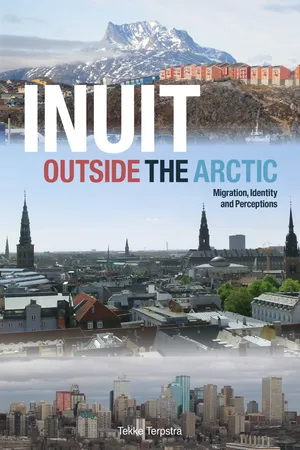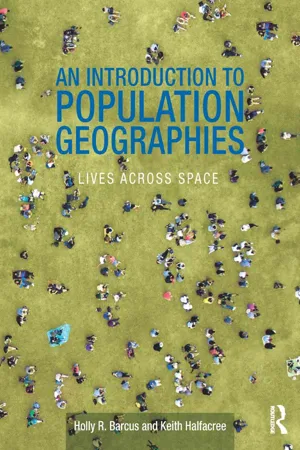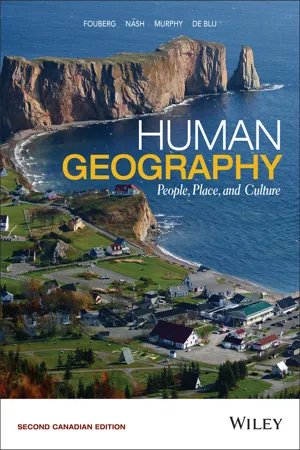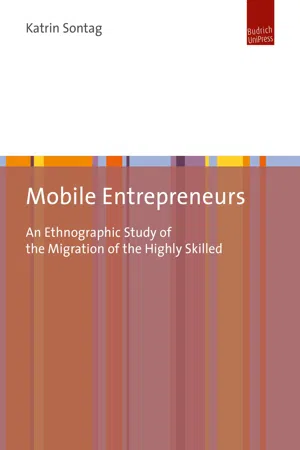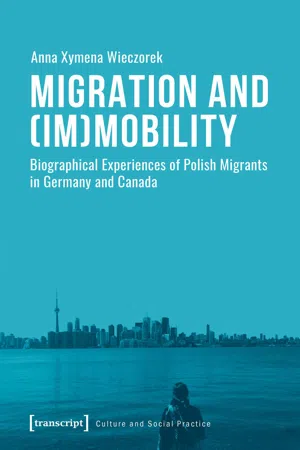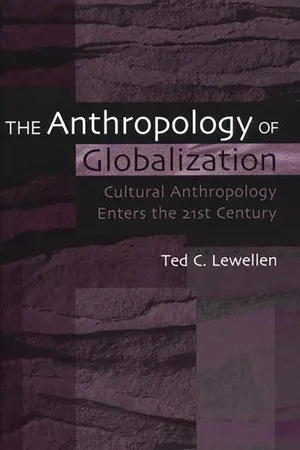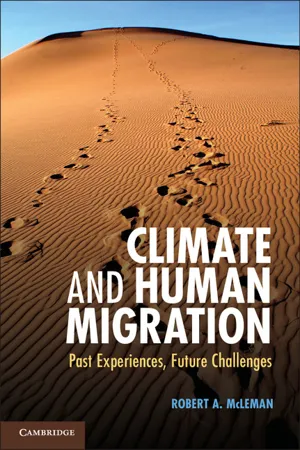Geography
Migration and Identity
Migration and identity are interconnected concepts that involve the movement of people from one place to another and the impact of this movement on their sense of self. Migration can influence individuals' cultural, social, and personal identities, as they navigate new environments and interact with different communities. This dynamic relationship between migration and identity is a key focus in the field of Geography.
Written by Perlego with AI-assistance
Related key terms
1 of 5
11 Key excerpts on "Migration and Identity"
- eBook - PDF
- Tekke Klaas Terpstra(Author)
- 2015(Publication Date)
- Barkhuis(Publisher)
2 Migration and Identity 2.1 Introduction This chapter presents the main concepts and the theoretical framework of the book. The concepts of Migration and Identity are the points of departure for this framework. After first explaining Migration and Identity separately, the concepts will be combined in order to provide for this book’s theoretical framework. 2.2 Migration Migration is a much debated subject in the current world. The integration of newcomers is often a trigger for political debates. The rise of several populist parties in various Western European countries which strive for stricter immigration rules is a clear sign of this. 1 Migration influences many people. Stephen Castles and Mark J. Miller explain that: The concept of the migratory process sums up the complex sets of factors and interactions which lead to international migration and influence its course. Migration is a process which affects every dimension of social existence, and which develops its own complex dynamics. The great majority of people in the world (97 per cent in 2000) (UNDESA, 2005) are not international migrants, yet their communities and way of life are changed by migration. The changes are generally much bigger for the migrants themselves, and they can be seen at every stage of the migratory process, whether in the country of origin, transit or destination (Castles and Miller 2009: 21). I consider migration to be both the actual movement from one place to another and also the process of settling at the new location. For that reason the concept of the migratory process is very useful. In addition, it is important to stress that migration takes various forms. According to the Human Development Report of 2009, published by United Nations Development Programme, which chose human mobility and development as its topic for that year, most migrants by far can be described as internal migrants as they move within their own country. - eBook - ePub
- Christine Inglis, Wei Li, Binod Khadria, Christine Inglis, Wei Li, Binod Khadria, Author(Authors)
- 2019(Publication Date)
- SAGE Publications Ltd(Publisher)
8 Geography and Migration Emily SkopIntroduction
This chapter considers how geographers take account of the inherently spatial phenomenon of migration. First, the chapter discusses the unique spatial perspective that broadly makes geography an ideal discipline for studies of migration, including utilizing core spatial concepts like space, place, networks, movement, scale, and territory, as well as the discipline's methodological diversity, and its tendency towards interdisciplinary engagement. Second, the chapter focuses on the way the discipline of geography has conceptualized and examined migration through a discussion of key theoretical framings within the field, including neoclassical spatial analysis, the socio-spatial lens, and the geopolitical turn. Third, the chapter reflects on the major developing trends and debates in the discipline of geography with regards to migration studies, with an eye towards future research and interdisciplinary perspectives, with special attention given to ‘crisis’ migration as well as the mobilities paradigm.The Discipline of Geography
Migration – a process that evolves over space and time – involves the continual reshaping of space as persons move. Migration has risen dramatically in the past two centuries, and the result is constant transformation and dislocation, which in turn has prompted significant attention to the phenomenon by geographers. Indeed, geographers are especially interested in migration because it continually disrupts and remakes geography, as spatial linkages and interconnections both form and dissolve when people move. The socio-spatial patterns, causes, and consequences of migration are innumerable and include complicated, multi-scalar phenomena, all of which are studied by geographers.The geographical lens encourages a unique spatial perspective when it comes to the study of migration. While definitions have been highly contested and subjected to pages of debate, below are some generalities that pertain to migration studies. Among its most important differentiating features, the geographical lens (and the spatial perspective more specifically) is: - eBook - ePub
An Introduction to Population Geographies
Lives Across Space
- Holly R. Barcus, Keith Halfacree(Authors)
- 2017(Publication Date)
- Routledge(Publisher)
CHAPTER 5Placing human migration5.1 INTRODUCTION: DEFINING MIGRATION
5.1.1 What is migration?
Migration remains the most widely studied and examined element within Population Geography (Boyle 2003, 2004). Moreover, whilst Geographers have played a pivotal role in shaping our contemporary understanding of it, the topic is of interest to numerous academic disciplines, including Demography, Sociology, Political Science, Economics and Anthropology (Brettell and Hollifield 2008a). In this respect, approaching migration as it occurs within the life course has considerable potential for bringing together a scattered body of scholarship often fragmented by “disciplinary partitioning” (Olwig and Sørensen 2002: 7).But what exactly is migration? Initially put, as in a recent textbook, it is “the movement of people to live in a different place” (Holdsworth et al. 2013: 96) or a “permanent change in residence.” It is residential relocation. Or, as expressed in UK and US censuses, a migration is deemed to have occurred when one’s “usual address” has changed within the last 1 or 5 years, respectively (ONS 2013; USCB 2013). Simple, then, one might think! However, as Holdsworth et al. (2013: 98) also noted, careful consideration of these definitions immediately raises a host of questions: what precisely is meant by “different place,” “live in,” “permanent,” or “usual address”? Consequently, by the end of the present chapter, “migration” will have been demonstrated to be at least as complex and multi-dimensional a concept as Chapter 4 revealed “fertility” to be.Starting with the idea of “different place,” the type of areal unit(s) involved in a migration is an initial important consideration when defining it specifically. A crucial starting point is whether a political boundary is crossed during a move. For example, an individual could move from one county to another within the same US state or from one state to another. Both moves are conventionally described as intra-national or internal migration, because neither involves leaving the US. In contrast, a move from the US to Canada, crossing an international border, is an international migration - eBook - PDF
Globalization, 3rd edition
Theory and Practice
- Eleonore Kofman, Gillian Youngs(Authors)
- 2008(Publication Date)
- Continuum(Publisher)
These sources of identity may include race, class, ethnicity, religion, gender, profession, and so on. For instance, a female migrant coming from a rural society may not be allowed to work in the traditional setting of the sending country, but the same person can cling to her gender identity after finding employment in the receiving country. Or, a Muslim migrant may become a more practicing Muslim, such as experiencing a closer adherence to Islam after his or her arrival in the receiving country. After arriving in Germany, for instance, a Turkish citizen of Kurdish origin may begin to feel more Kurdish than Turkish; or after migrating to France a Moroccan citizen with Berber origin may define himself or herself with the identity of being a Berber rather than being a Moroccan. They may give over-emphasis to their existing identities, or suppress them. Hall (1990: 225) de- fines identity as 'the names we give to the different ways we are positioned by, and position ourselves within, the narratives of the past. In this sense, identities are both imposed and self-made. Migration plays a de-constructive role by positioning the migrant in a totally new socio-political environment and blurring the distinction between private and public realms. Various identities that were previously held in the private realm can find acceptance in the public realm within the migratory setting. Indeed, the opposite is also possible. Migration also problematizes the disarticulation and re-articulation of the activity side of citizenship, that is, civic virtue. In most cases there are fundamental differences between the civic traditions of the sending and receiving countries. When we consider that - eBook - ePub
- Tabea Linhard, Timothy H. Parsons, Tabea Linhard, Timothy H. Parsons(Authors)
- 2018(Publication Date)
- Palgrave Macmillan(Publisher)
The synergies between these concepts are intense: identities are ‘placed’ and places have their own (contested) identities; identities are also about fluid borders (between ‘them’ and ‘us’); whilst the relationship between space and place is interlocking in the fashion of a Russian doll—spaces are made up of places which in turn contain micro-spaces and so on. This latter point is brilliantly explored by geographer Doreen Massey in her extensive writings on space and place. 7 Both places and spaces, at various scales, are inherently tied to identities and their formation, as well as being shaped by particular histories of social relations. These social dynamics may be shaped by Marxian relations of capital and labour, producing spaces and places which are feudal, industrial, or based on trade and commerce. For the people who live there, their sense of place is partly defined by these underlying structures of power. But these place - and region-based identities are fluid and contested. Migration is often a major part of these contested place identities, disrupting the ‘naturalised sense of place’ that some argue is part of one’s identity. And then there is time—both historical time and the varied temporalities of migration and mobility. Donna Gabaccia reminds us that migration, mobility and human spatial movement are fundamental norms of human history. 8 People have always moved, and there is no reason to believe that this mobility will stop, no matter how many walls and barbed wire fences are built by regimes and despots who fail not only to express a modicum of humanity to those less fortunate but also to grasp the fundamental historicity of migration and its basic economic, social and cultural drivers. Whilst there have been many histories of migration in the world, or in parts of it, the ‘timeness’ of migration has been understudied. 9 By this I mean how the very process and experience of migration unfolds in time (and space) - eBook - PDF
Human Geography
People, Place, and Culture
- Erin H. Fouberg, Alexander B. Nash, Alexander B. Murphy, Harm J. de Blij(Authors)
- 2015(Publication Date)
- Wiley(Publisher)
What is the connection between identity and place? 4. How does geography reflect and shape power relationships among groups of people? 7.1 What Is Social Geography? Geographers are interested in how our social lives and the places we live, work, and play—our social geographies—are intertwined. Every day we interact with any number of people across a variety of places. We talk to the members of our household, we nod to strangers and say “good morning,” we exchange pleasantries with co-workers, and we mix with others at baseball games or the opera. These are examples of social “relations”—that is, the interactions and relationships we have with others around us. In this chapter, we focus on the shifting relationships between the spatial and the social with a particu- lar focus on the specific social categories of gender, race, class, ethnicity, and sexuality. These social categories or identities are the ones we are asked to identify with in a variety of social situations, from answering questionnaires and census forms to applying for housing, opening a bank account, or joining a gym. While these examples speak to our individual experiences, social geographers also consider how these individual identities come to be understood collectively as constituting a distinct social group, such as the “elderly,” “teenagers,” or the “working class.” Understanding how collective identities come into being and are understood is important because of the social and po- litical implications of collective identity formation. For exam- ple, since the end of the Second World War, a number of new political and social movements have emerged based on contest- ed understandings of various categories of identity—the Aboriginal rights movements, the black civil rights movement, the gay rights movement, and the women’s rights movement. - Available until 15 Jan |Learn more
Mobile Entrepreneurs
An Ethnographic Study of the Migration of the Highly Skilled
- Katrin Sontag(Author)
- 2018(Publication Date)
- Budrich UniPress(Publisher)
69 5 Movement: Migration or Mobility? I am sitting in the entrance area of a co-working space in black leather seats opposite the reception counter. People keep coming in through the revolving door. Opposite the door is an elevator, behind it a huge hall leading to different offices. A young man rides through the hall on a little lightweight scooter – also an invention by a Swiss startup. My interview partner comes up to greet me right on time, wearing a hooded sweater and jeans. He intro-duces himself by his first name and immediately uses the more familiar German form of addressing me. We settle at a café for a second breakfast. 18 5.1 Forms of Migration The people I encountered could be classified as migrants. Yet there are dif-ferent ways in which people move over the course of a lifetime. Common definitions of migration differentiate between migration, transmigration, circular mobility, multilocal living or second generation migrants. 1. Migration: Limmer and Schneider define migration as “permanent trans-national mobility” (Limmer & Schneider, 2008, p.21). 2. Transmigration is a movement from one place to the next and on to the next, “a permanent movement across borders without a clear notion of geographical destination” (Limmer & Schneider, 2008, p.21). 3. Circular mobility “includes recurring forms of mobility, with mobile subjects returning, after times of absence, to their place of origin, respec-tively their permanent residence” (Limmer & Schneider, 2008, p.21). Commuting and travelling would also be ranged under this heading. 4. Multilocality is the simultaneous existence of two or more offices or liv-ing places in different locales. Multilocal living even more specifically describes living in different places at the same time: “Multilocal living means organizing daily life across several living places” (Hilti, 2009, p.81, my translation). 5. People whose parents migrated also appear in some studies as migrants or second generation migrants. - eBook - PDF
Migration and (Im)Mobility
Biographical Experiences of Polish Migrants in Germany and Canada
- Anna Xymena Wieczorek(Author)
- 2018(Publication Date)
- transcript Verlag(Publisher)
While such a broad idea includes a wide range of individuals and social phenomena, it also leads to analytical blur (Pries 2008: 227). If geograph-ical mobility is not a defining feature of a perspective that is concerned with border-crossing activities of migrants, what then remains? I would say: seden-tariness and the notion of “sedentary migrants.” 5 When, for the sake of the ar-gument, transnationalism is a sedentary notion, I wonder how it differs from oth-er sedentary notions, say, multiculturalism. Many immigrants (and their de-scendants) follow multicultural practices (as opposed to assimilationist ones) like speaking their heritage languages and living in line with traditional values and 5 For a similar reading, see Dahinden 2010, and my review of her work in ch. 1.2. Revisiting Migration | 273 norms in many ways. Indeed, they are often managing several cultural reper-toires and sometimes they struggle, for instance, with their parents’ expectations that they marry someone from their own religious community. If Levitt refers to such examples as transnational activities (2009), they qualify as multicultural ones as well, I argue. However, others take geographical mobility into consideration when concep-tualizing transnational phenomena. Within these literatures, mobility is based on different temporal and spatial frames. The geographical movements of “transna-tional migrants” can vary in their duration: some works include travel and holi-daying as a characteristic of (migrant) transnationalism (Wessendorf 2013), oth-ers imply more enduring mobility of migrants relocating their center of life for a certain amount of time (Pries 2001b), and yet others include profession-bound extensive mobility of migrants which leads to multiple short-term stays abroad (Nowicka 2006b). Many of these (labour-inflected) mobility trajectories require and produce specific social conditions, which cannot be grasped by traditional concepts such as of em/immigration. - eBook - PDF
The Anthropology of Globalization
Cultural Anthropology Enters the 21st Century
- Ted C. Lewellen(Author)
- 2002(Publication Date)
- Praeger(Publisher)
However, some significant elements of a new analytical framework emerged. First, any comparison of migrations required historical depth in order to differentiate the present form, based on global capitalism, from past forms. Second, the idea of space needed to be rethought, including the ways that space is symbolically manipulated and contested. Third, regimes of power, both within and outside of governments, must be clarified and re- lated to the abilities of people to determine their own fates and control their own identities. Finally, identity politics emerging from migration needs to be analyzed in relation to the restructuring of the global economy and other transnational processes. Migration studies, perhaps more than any other aspect of the anthropol- ogy of globalization, have been a matrix for the introduction and elabora- tion of new concepts of space and identity. Testing Migration Theories in Jalisco, Mexico In Los Arboles, a relatively well-off rancho (roughly "community") in Jalisco, Mexico, three-quarters of the 152 male heads of household repeat- edly migrate to the United States for work. Many of the residents are from surrounding ranchos, pushed off of share-cropped land by the mechaniza- tion of agriculture. Landlessness, or ownership of only a few hectares, plus a lack of permanent jobs in the area stimulate a high degree of transnational labor migration. This situation provided Tamar Diana Wilson (1994) with the data to test three standard theories of migration. Thefirsttheory, the immigration market model, views potential migrants as economic cost-benefit analysts who rationally measure the advantages and disadvantages of various countries and regions in terms of wealth maxi- mization. Because this theory focuses on legal, documented immigrants, 138 Globalization and Migration the selection process on the part of the target state is also important; educa- tion and particular skills will be advantaged. - eBook - PDF
Climate and Human Migration
Past Experiences, Future Challenges
- Robert A. McLeman(Author)
- 2013(Publication Date)
- Cambridge University Press(Publisher)
For migrants travelling long distances to settle in new and unfamiliar places, migration may be a long and arduous process, with integration into the destination population never completed within the migrant’s own lifetime, but continued by subsequent generations. The migration process as experienced by the individual does not exist in a vacuum; it is nested within larger sets of dynamic and interconnected cultural, economic, envi- ronmental, political, and social processes that shape human behavior more gener- ally. A decision to migrate today may be the product of any number of antecedent 2 Why People Migrate 2.2 Basic Assumptions of Modern Migration Research and Their Origins 17 conditions and events. And, once acted upon, the decision to migrate generates new sets of risks and opportunities not only for the migrant, but for his or her social net- work, and for the sending and receiving communities as well. Migration is more than simply a movement across physical space; it is a change in the trajectory of an indi- vidual and those connected to that individual through social space. The aim of this chapter is to provide the nonspecialist a clear overview of current scholarly understanding of the migration process and to introduce a set of basic the- ories, concepts, and terms that: Have been used in a wide variety of settings to explain and interpret how migration deci- • sions are made and the factors that shape migration behavior generally; Can be used to describe and analyze in a systematic fashion known examples of migration • related to droughts, floods, extreme weather events, and other climate-related phenomena; and Will be combined in • Chapter 3 with scholarship that considers human vulnerability and adaptation to climatic variability and change in order to create a conceptual framework that shows the interactions between climate and migration within the context of an adaptive human-environment system. - eBook - PDF
Mobilities of Self and Place
Politics of Wellbeing in an Age of Migration
- Mahni Dugan(Author)
- 2019(Publication Date)
- Rowman & Littlefield Publishers(Publisher)
Each one is a nexus in an apparently infinite field of relationships; at the centre of connections that span causal conditions of conflict or strife, and which motivated those people to risk safety and life to flee from their places of origin; that extend outwards both spatially (here, there, between) and temporally (past, present, future). Consider other connec-tions of personal relationships with community and to friends and families left behind; to people dead and living; to those praying that each traveller’s journey might offer new hope for a safe and decent life; and to others who would wish them ill. Consider connections to places of origin, transition, and destination, in which are entangled the possibilities of asylum, refuge, resettlement, and freedom; or detention behind razor wire – with loss of rights and identity, trauma, and even death. In short, migrations are intricately connected with movement and change in politics, economies, social structures, and governance – that is, forms of the conduct of conduct – from the personal to the local to the global. 2 This 54 Chapter 3 complex connectivity is at the heart of emerging interdisciplinary studies of mobilities. 3 Peter Adey describes mobility as both a relational concept and a process deeply involved in how we address the world and make sense of it, and implicated in how we engage with other people and places. 4 Adey sees mobilities as “surely as important to us as the conceptions and debates that surround notions of space, time and power”. 5 Any mobility always involves other mobility; because to be mobile is to be capable of moving or of being moved, and because movement can only occur in relation to something other, any movement invokes mobilities. What is at stake is not whether things do or do not move but rather the frames or perspectives we use to determine what those mobilities mean.
Index pages curate the most relevant extracts from our library of academic textbooks. They’ve been created using an in-house natural language model (NLM), each adding context and meaning to key research topics.
